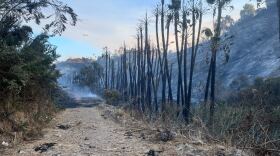In the coming months, U.S. troops may have more close contact with migrants along the U.S.-Mexico border. So far, though, the military has tried to keep troops away from direct contact with the people at the center of the border mission.
Soldiers and Marines are stretched along the border from California to Texas, monitoring mobile surveillance cameras at 150 sites. Sitting in trucks provided by the Border Patrol, troops at times are so far from the border that soldiers say they can’t tell whether they’re looking at a cow or a person. Even so, they are armed, says task force Commander Lt. Col. Timothy Gatlin.
“A soldier or a Marines is always authorized to defend him or herself, but that is not why we are here,” Gatlin said. “That is not why the service member has the sidearm. We are not taught to engage in this particular mission set. We want to de-escalate every situation we come in contact with and turn it over to the supporting element, which is the Border Patrol.”
Soldiers from Joint Base Lewis-McChord near Tacoma, Washington, are stationed around El Paso. They have been drilled on the rules of force when working with the Border Patrol. Customs and Border Protection gave them about 40 hours of training on the equipment and how to react when someone approaches, Gatlin said.
“Training that we got before and during the mission really just tells us that we want to be able to back away from any engagement and get on the B.P. radio and radio to our B.P. partners.”
Soldiers carry flashcards in Spanish to communicate with asylum seekers and other migrants. Troops mainly encounter people looking for water or people who want to turn themselves into the Border Patrol, said Col. Paul Nathan Garcia, deputy commander of Joint Task Force North, which is in charge of the operation.
“I would say across the entire southwest border, we’ll have one or two (encounters) that happen,” he said. “I’m talking 2,000 miles of southwest border, 150 sites, that we’ll mainly have a couple a week.”
A handful of more serious encounters have been made public. On April 13, 2019, five to six members of the Mexican military stopped and questioned two U.S. Army soldiers in an unmarked CBP vehicle near the border outside Clint, Texas. A CBP and Pentagon review found the Mexican troops mistakenly believed the U.S. Army soldiers were south of the border with Mexico, said Col. Cathy Wilkinson, spokesperson for the border mission.
In another incident, two service members assigned to the Defense Department’s Southwest Border Support mission were involved in the negligent discharge of a military-issued handgun during mobile surveillance camera operations in Yuma, Arizona, on May 12. One person received injuries that were not life-threatening and is in stable condition after being treated at a civilian hospital. This incident is under investigation, Wilkinson said.
On May 19, soldiers reported someone pointing a gun at them. CBP responded with the Yuma County Sheriff's Office and apprehended the suspects, Wilkinson said.
Also, a Marine discharged his weapon on May 29 while stationed at a mobile surveillance site near El Centro. An investigation is ongoing, she said.
Brig. Gen. Walter Duzzny, the deputy commanding general of U.S. Army North, says contact between troops and migrants is infrequent.
“It is very uncommon. Especially for the duration of the operation and, really, the size of the operation, in terms of the geographic size of the border, it’s extremely small,” he said.
Since the border mission began in October, troops have mostly performed missions that keep them away from anyone crossing the border. Soldiers and Marines laid miles of concertina wire and erected barriers at the ports of entry. Troops have aided in the apprehension of 13,000 people and the seizure of 3,000 pounds of marijuana.
The numbers are small compared to the traffic coming across the southern border at the moment. CBP released figures showing 593,507 migrants have been taken into custody since the beginning of the year. The agency takes in roughly 5,863 pounds of narcotics a day, on average.
By working surveillance and other missions along the border, troops are freeing up border agents to take a more active role. It’s a mission soldiers and Marines are able to undertake, Duzzny said.
El Paso is also a military town. Rosa Saenz owns Los Bandidos De Carlos and Mickeys, a busy Mexican restaurant, just south of Fort Bliss. On a recent day, some of her customers were in Army uniforms. Saenz is one of several restaurant owners who deliver food to asylum seekers dropped off by the Border Patrol. People in the community feel there are problems related to the way migrants are being handled, but so far, people don’t blame the military, she said.
“In El Paso, we understand what the military is about,” Saenz said. “We don’t blame them. We know they’re following orders. They’re doing their jobs. How you follow orders, of course, you know, you can either do it with a certain amount of assertiveness or you can do it with the understanding that these are just people.”
Troops could become more visible all along the border. The Pentagon has agreed to begin transporting migrants to detention facilities and providing food service. Troops will also build six new detention facilities, though the details of these operations haven’t been released. The US. Army Corps of Engineers is also in charge of constructing portions of a border wall.








